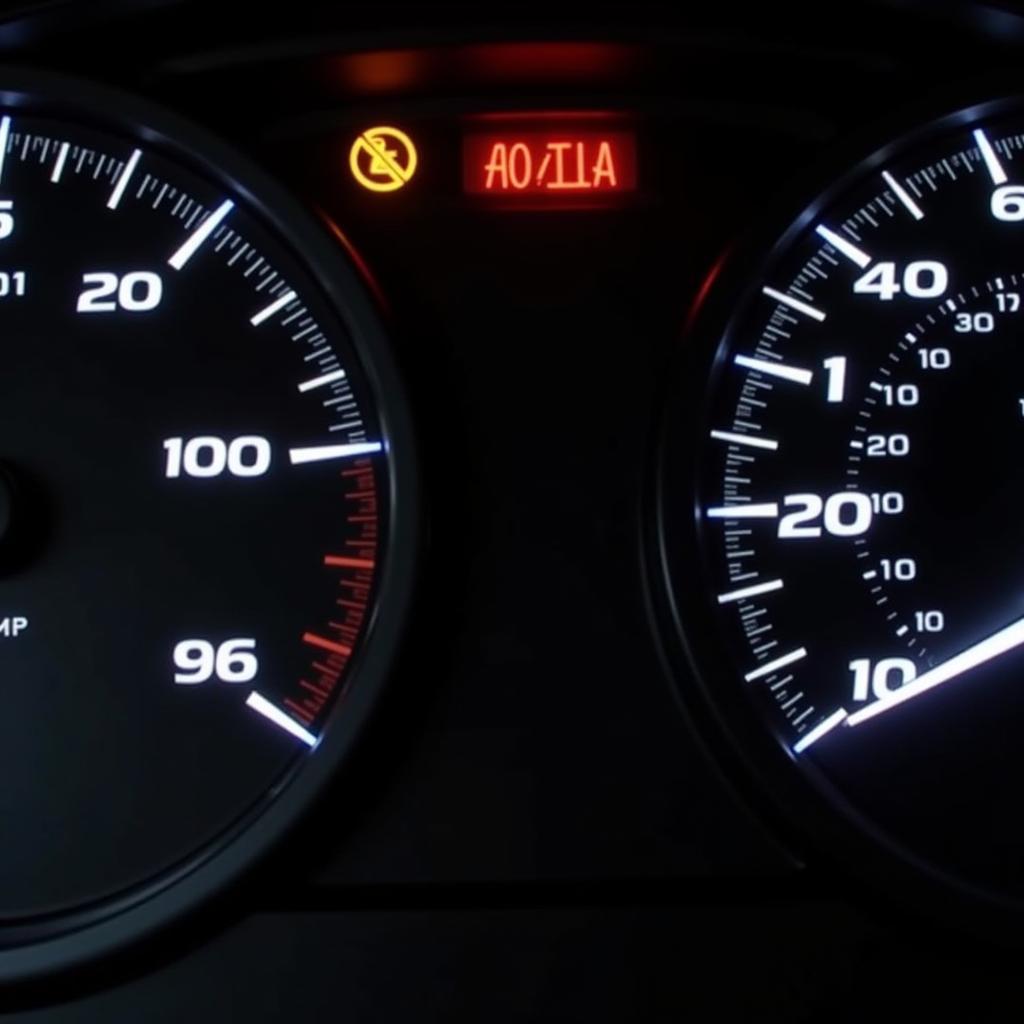The dashboard brake warning light symbol is a crucial safety indicator in your vehicle. Seeing this illuminated on your dashboard can be alarming, but understanding its meaning can save you from costly repairs and ensure your safety on the road. This article will delve into the common causes, troubleshooting steps, and solutions for a lit brake warning light.
The appearance of the brake warning light, often a circled exclamation point or the word “BRAKE,” signals a potential issue within your braking system. This could range from something as simple as a low brake fluid level to more serious problems like worn brake pads or a malfunctioning ABS system. Let’s explore these possibilities in detail.
Common Causes of a Dashboard Brake Warning Light Symbol
Several factors can trigger the dashboard brake warning light symbol. Identifying the root cause is the first step towards resolving the issue. Here are some of the most common culprits:
- Low Brake Fluid: This is the most frequent reason for the warning light. Brake fluid is essential for transmitting pressure from the brake pedal to the brake calipers, enabling your car to stop. A leak in the brake lines or worn brake pads can cause the fluid level to drop.
- Worn Brake Pads: Brake pads are designed to wear down over time. When they become too thin, a sensor triggers the warning light, indicating the need for replacement.
- Parking Brake Engaged: Sometimes, the simplest explanation is the correct one. If the parking brake is even slightly engaged, the warning light may illuminate. Make sure the parking brake is fully released.
- ABS System Malfunction: The Anti-lock Braking System (ABS) prevents wheel lockup during hard braking. A malfunction within this system, such as a faulty sensor or pump, can trigger the warning light.
- Brake System Leaks: Leaks in the brake lines or other components can lead to a loss of brake fluid and pressure, illuminating the warning light and compromising braking performance.
You can learn more about specific brake warning light issues on vehicles like the Honda CRV 2016 at brake pad warning light on honda crv 2016 dashboard symbols.
How to Troubleshoot the Dashboard Brake Warning Light Symbol
Once the dashboard brake warning light symbol appears, it’s crucial to investigate the problem promptly. Here’s a step-by-step guide to help you troubleshoot:
- Check the Parking Brake: Ensure the parking brake is fully disengaged.
- Inspect the Brake Fluid Level: Locate the brake fluid reservoir under the hood and check the fluid level. If it’s low, add brake fluid of the correct type. However, persistently low fluid suggests a leak that requires professional attention.
- Examine Brake Pads: Visually inspect the brake pads through the wheel spokes. If they appear thin, consult a mechanic for replacement.
- Test the Brakes: Drive the car cautiously in a safe area and test the brakes. Note any unusual noises, vibrations, or a spongy brake pedal feel. These can indicate more serious problems.
When to Seek Professional Help
While some issues can be resolved with simple checks, others require professional expertise. If you notice any of the following, consult a qualified mechanic immediately:
- Persistent Low Brake Fluid: This indicates a leak that needs immediate attention.
- Spongy Brake Pedal: A soft or spongy brake pedal feel suggests a loss of brake pressure.
- Grinding or Squealing Brakes: These noises typically indicate worn brake pads.
- ABS Warning Light Illuminated: This signals a problem with the Anti-lock Braking System.
- Difficulty Stopping: Any noticeable change in braking performance necessitates immediate professional inspection.
“Ignoring a dashboard brake warning light symbol can lead to serious safety hazards and costly repairs. Addressing the issue promptly ensures your safety and prevents further damage to the braking system.” – John Miller, Automotive Diagnostics Specialist.
Dashboard Brake Warning Light Won’t Reset?
Sometimes, even after addressing the underlying issue, the dashboard brake warning light symbol might persist. This can be due to a faulty sensor or a glitch in the car’s computer system. If you’ve checked everything and the light remains on, consider seeking professional diagnostic services. This may involve resetting the light using specialized diagnostic tools or repairing a malfunctioning sensor. Check out mini brake warning light won t reset for more information on specific reset procedures. Knowing about potential warnings on various car models, such as the Jaguar XF, can be helpful. You can find more information regarding the jaguar xf brake pad warning light.
 ABS System Malfunction Warning Light
ABS System Malfunction Warning Light
Conclusion
The dashboard brake warning light symbol is a critical safety feature that should never be ignored. Understanding its meaning and taking prompt action can prevent accidents and save you from costly repairs. By following the troubleshooting steps outlined in this article and seeking professional help when necessary, you can ensure your vehicle’s braking system remains in optimal condition and keep you safe on the road. Remember, a properly functioning braking system is paramount to your safety and the safety of others. If you are experiencing issues with your dashboard brake warning light symbol, don’t hesitate to address the problem promptly. You can also find valuable information on other car warning lights, such as those for the Seat Alhambra at seat alhambra warning. Furthermore, for a comprehensive overview of various dashboard warning lights, refer to the guide on car dashboard brake warning light symbol.
“Regular maintenance and prompt attention to warning signs are crucial for maintaining a reliable and safe braking system.” – Sarah Chen, Automotive Engineer.
